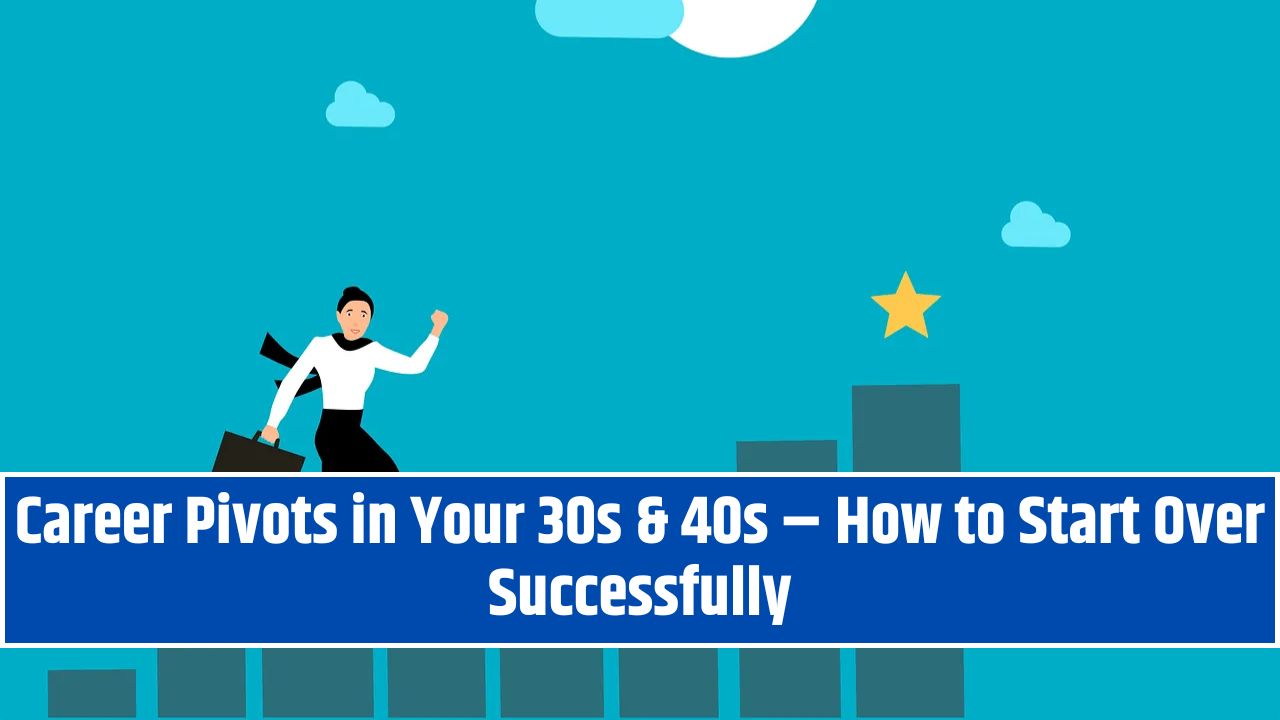Ever wake up and think: “Wait… how the hell did I end up here?”
You’re not alone. Maybe your job pays the bills, but you feel like you’re starring in someone else’s movie. Maybe you’ve outgrown your role. Or your industry. Or the entire version of yourself that picked this career 15 years ago.
Here’s the thing: starting over doesn’t mean you failed. It means you outgrew the cage you once thought was a castle.
I pivoted careers in my mid-30s. Left behind the cushy salary, the cute office plants, and the safe corporate cocoon for a messy, creative path that terrified and thrilled me. Was it smooth? Nope. Worth it? Absolutely.
If you’re reading this with a half-sigh and a double espresso in hand, wondering if it’s “too late” to switch lanes — spoiler alert: it’s not.
Let’s unpack it all.
First: Ditch the Myth of “Too Late”
You’ve probably heard it. Maybe even believed it.
“I can’t start over now. I’ve invested too much.”
You know who else said that? People stuck in unhappy lives for decades. It’s called the sunk cost fallacy — staying in something just because you already spent time or money on it.
Time isn’t a prison sentence. It’s a resource. And guess what? You still have a ton of it left. People live well into their 80s and 90s now. You could have another 30+ working years ahead of you.
Imagine staying stuck for three more decades because you were afraid to pivot in your 30s or 40s. Eww. Nope. That’s a horror movie, not a life plan.
My Story: Corporate Climber Turned Coffee-Fueled Creative
Let me get personal for a sec.
I was deep in tech marketing. Good money. Title looked sparkly on LinkedIn. But I’d open my laptop every Monday and feel like someone had dropped a wet blanket on my soul.
I started journaling. Took night classes in creative writing. Eventually, I began freelancing on weekends. One by one, I built a bridge out of the old life — not with a leap, but with little, clumsy steps.
The day I sent in my resignation? My hands were shaking. But so was my soul — with excitement.
Now I write full-time. And I’ll be real with you: it ain’t all rainbows. Some days feel like herding squirrels. But I’m free. I’m alive. I’m myself.
Inspiration Station: People Who Pivoted Big
- Julia Child didn’t start cooking seriously until her late 30s. Her first cookbook was published when she was 50.
- Vera Wang entered the fashion industry at 40.
- Colonel Sanders launched KFC in his 60s.
- Martha Stewart was a stockbroker before she built her home empire.
You don’t need to have it all figured out by 25. That’s a myth from a generation that didn’t have TikTok or food delivery apps. We’re playing a new game now.
The Pivot Plan – How to Start Over (Without Losing Your Mind)
1. Audit Your Life (Not Just Your Job)
Ask yourself:
- What drains me?
- What lights me up?
- What would I do even if no one paid me?
- What do I never want to do again?
Pivoting isn’t just about getting a different job. It’s about designing a life that fits your values now — not who you were ten years ago.
2. Get Curious Before You Get Drastic
Before you quit, explore.
Take an online course. Shadow someone. Volunteer in a related field. Side hustle. You don’t need to jump — you can tiptoe into new waters.
I started blogging anonymously. It gave me confidence and clarity. I realized I wasn’t crazy for wanting something different — I just needed proof I could do it.
3. Upgrade Your Skills (Strategically)
Look at job listings in the new field you’re eyeing. Spot the common keywords. Then go learn those things. Platforms like Coursera, Skillshare, and LinkedIn Learning are gold mines.
And don’t forget soft skills. Leadership, communication, emotional intelligence — these don’t age. They compound.
4. Rewrite Your Story (Literally)
People will ask why you’re switching. Heck, you’ll ask yourself.
Practice your new story:
“After 15 years in finance, I realized I wanted to help people in a more direct, human way — so I transitioned into health coaching.”
Own it. Frame your past as a foundation, not a mistake.
5. Find Your New Tribe
Surround yourself with people who believe in reinvention. Join communities, attend meetups, stalk people on LinkedIn (but like, in a chill way).
Your environment shapes your mindset. Don’t hang out with dream-killers who act like ambition expires at 35.
Real Talk: What About Money?
Yep. Let’s go there.
You may take a pay cut at first. Or juggle two roles for a while. Or dip into savings. It can be scary. But with a plan, it’s survivable — and often temporary.
Create a “pivot cushion” — save a few months of expenses before making a big leap. Budget ruthlessly. Cut back on fluff (looking at you, overpriced smoothies).
Also, remember: money isn’t the only currency. Time, freedom, meaning — those matter more in the long run.
Emotional Whiplash Is Normal
Some days you’ll feel like Beyoncé. Other days, you’ll cry in your car wondering if you made a huge mistake.
That’s part of it.
Give yourself grace. This is not a linear journey. It’s a freaking rollercoaster — loops, dips, that one scary part where you can’t see the track. But you will get to the other side.
And honestly? It’s a better ride than sitting on the same carousel, going in circles forever.
Final Thoughts: Reinvention Is the Real Glow-Up
Forget the wrinkle creams and the gym memberships.
The real glow-up in your 30s and 40s is becoming the you you were always meant to be — bolder, wiser, and less interested in other people’s expectations.
Changing careers isn’t reckless. It’s radical self-respect.
You are not behind. You are not broken. You are just beginning again — and this time, with way more wisdom, grit, and coffee.
So go on. Tear up the old script. Write a new chapter. You’ve got the pen now.




